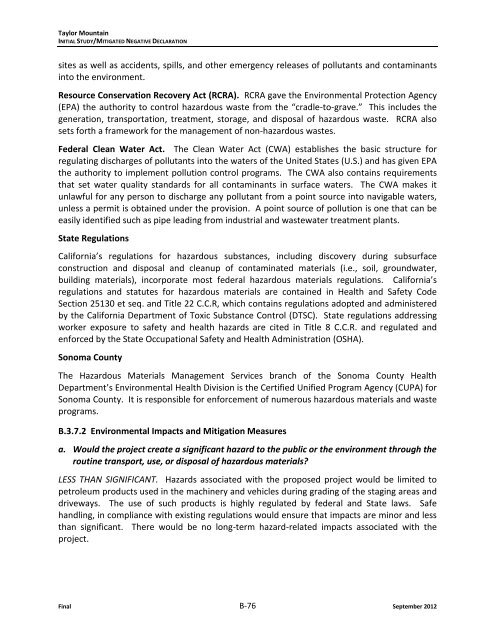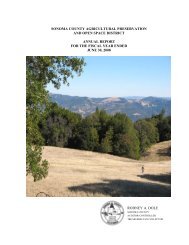Initial Study MND - Sonoma County Agricultural Preservation and ...
Initial Study MND - Sonoma County Agricultural Preservation and ...
Initial Study MND - Sonoma County Agricultural Preservation and ...
You also want an ePaper? Increase the reach of your titles
YUMPU automatically turns print PDFs into web optimized ePapers that Google loves.
Taylor MountainINITIAL STUDY/MITIGATED NEGATIVE DECLARATIONsites as well as accidents, spills, <strong>and</strong> other emergency releases of pollutants <strong>and</strong> contaminantsinto the environment.Resource Conservation Recovery Act (RCRA). RCRA gave the Environmental Protection Agency(EPA) the authority to control hazardous waste from the “cradle-to-grave.” This includes thegeneration, transportation, treatment, storage, <strong>and</strong> disposal of hazardous waste. RCRA alsosets forth a framework for the management of non-hazardous wastes.Federal Clean Water Act. The Clean Water Act (CWA) establishes the basic structure forregulating discharges of pollutants into the waters of the United States (U.S.) <strong>and</strong> has given EPAthe authority to implement pollution control programs. The CWA also contains requirementsthat set water quality st<strong>and</strong>ards for all contaminants in surface waters. The CWA makes itunlawful for any person to discharge any pollutant from a point source into navigable waters,unless a permit is obtained under the provision. A point source of pollution is one that can beeasily identified such as pipe leading from industrial <strong>and</strong> wastewater treatment plants.State RegulationsCalifornia’s regulations for hazardous substances, including discovery during subsurfaceconstruction <strong>and</strong> disposal <strong>and</strong> cleanup of contaminated materials (i.e., soil, groundwater,building materials), incorporate most federal hazardous materials regulations. California’sregulations <strong>and</strong> statutes for hazardous materials are contained in Health <strong>and</strong> Safety CodeSection 25130 et seq. <strong>and</strong> Title 22 C.C.R, which contains regulations adopted <strong>and</strong> administeredby the California Department of Toxic Substance Control (DTSC). State regulations addressingworker exposure to safety <strong>and</strong> health hazards are cited in Title 8 C.C.R. <strong>and</strong> regulated <strong>and</strong>enforced by the State Occupational Safety <strong>and</strong> Health Administration (OSHA).<strong>Sonoma</strong> <strong>County</strong>The Hazardous Materials Management Services branch of the <strong>Sonoma</strong> <strong>County</strong> HealthDepartment’s Environmental Health Division is the Certified Unified Program Agency (CUPA) for<strong>Sonoma</strong> <strong>County</strong>. It is responsible for enforcement of numerous hazardous materials <strong>and</strong> wasteprograms.B.3.7.2 Environmental Impacts <strong>and</strong> Mitigation Measuresa. Would the project create a significant hazard to the public or the environment through theroutine transport, use, or disposal of hazardous materials?LESS THAN SIGNIFICANT. Hazards associated with the proposed project would be limited topetroleum products used in the machinery <strong>and</strong> vehicles during grading of the staging areas <strong>and</strong>driveways. The use of such products is highly regulated by federal <strong>and</strong> State laws. Safeh<strong>and</strong>ling, in compliance with existing regulations would ensure that impacts are minor <strong>and</strong> lessthan significant. There would be no long-term hazard-related impacts associated with theproject.Final B-76 September 2012







